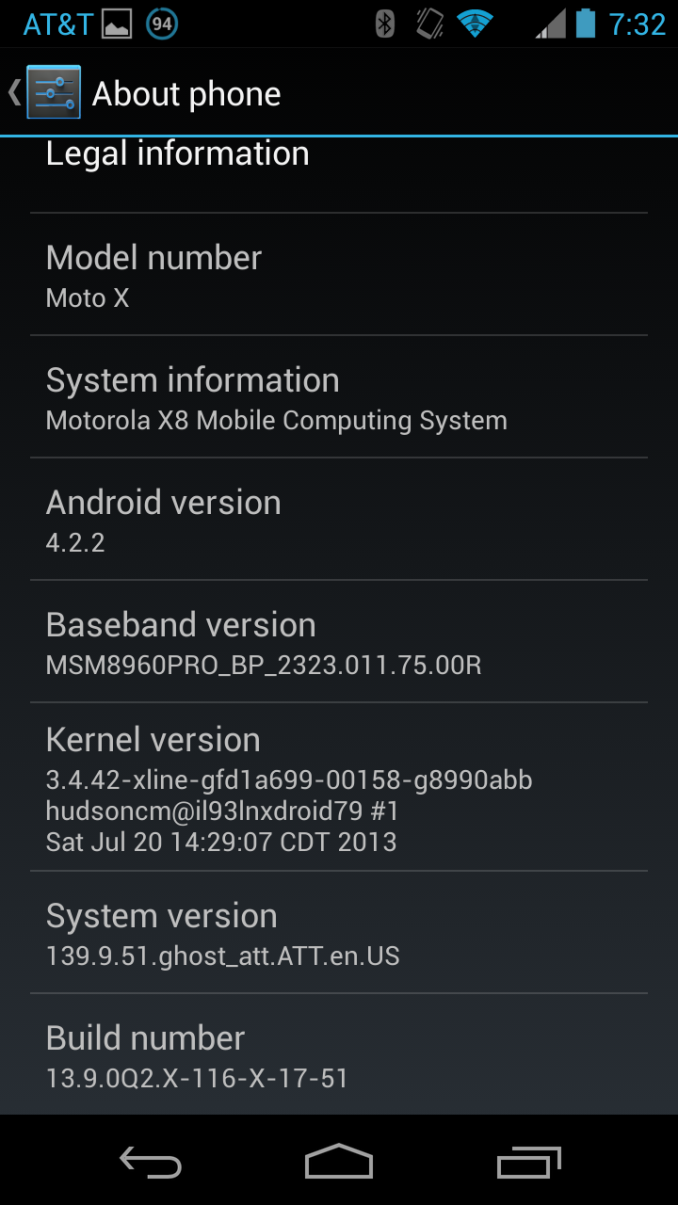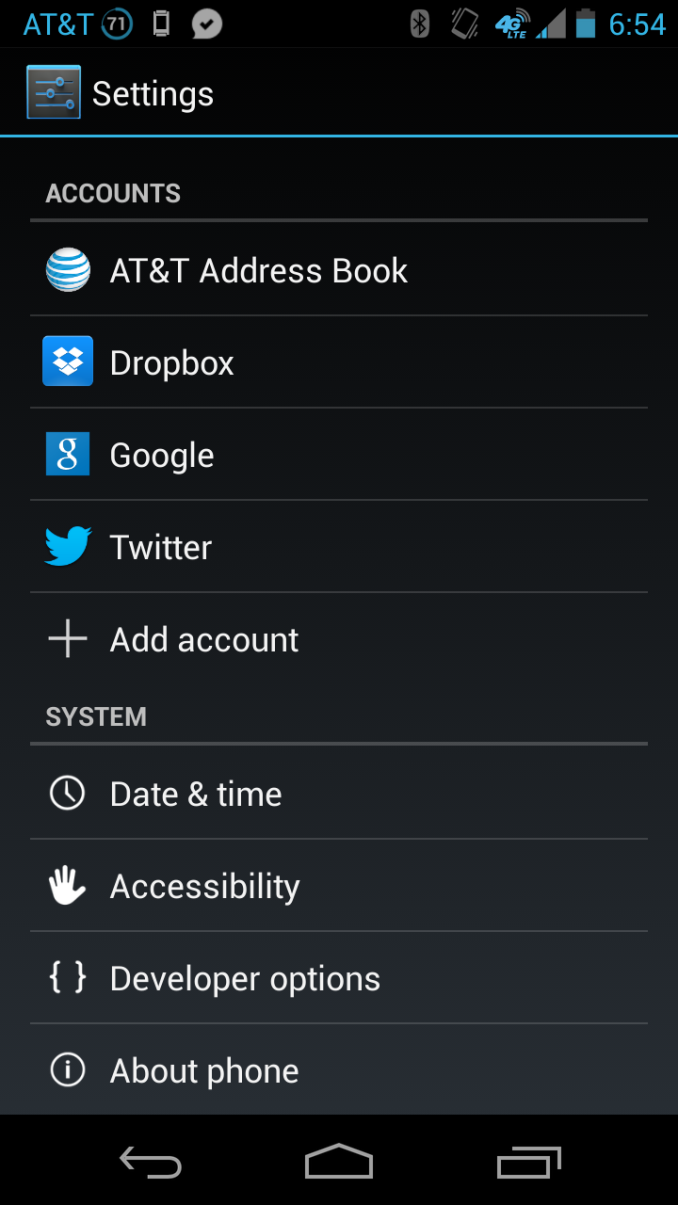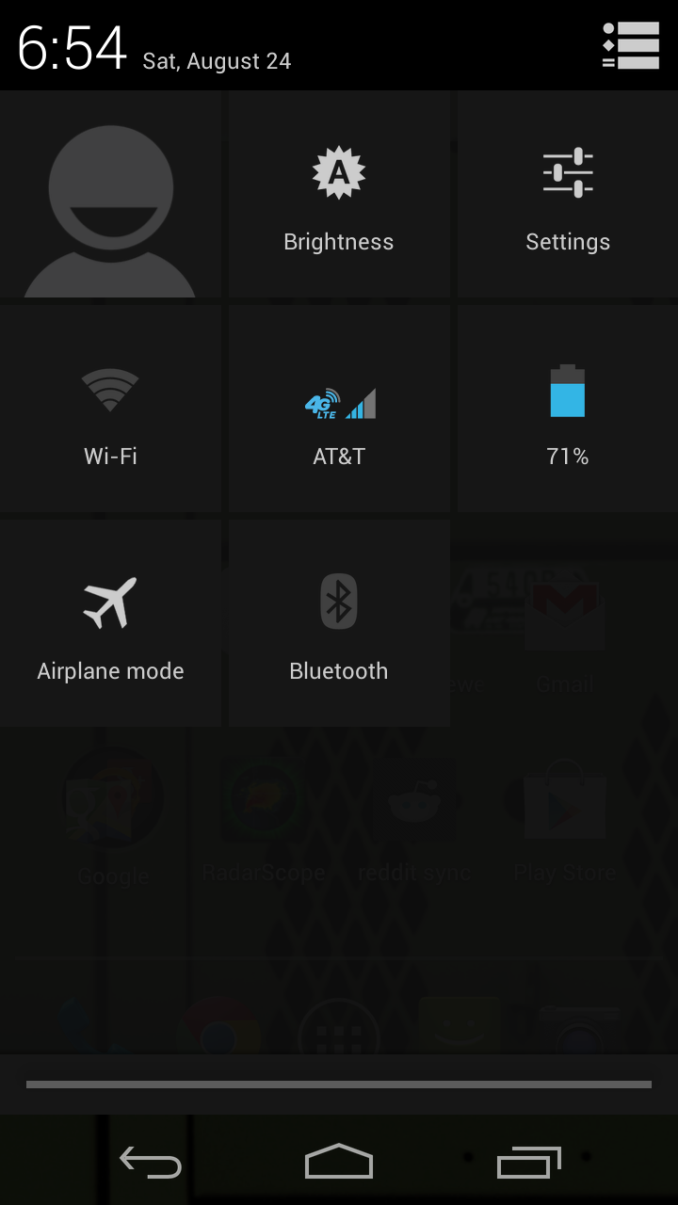Moto X Review
by Brian Klug on August 26, 2013 1:30 PM EST- Posted in
- Smartphones
- Qualcomm
- MSM8960
- Motorola
- Android
- Mobile
- Android 4.2
- Moto X
Somewhat Stock Android
One of the first things that changed for Motorola under its new Google ownership was the final nail through the coffin for Motoblur, with OTA updates for some of its handsets gradually scaling back customized features in favor of stock ones. I joked with Anand that Google paid $12.5 billion for Motorola just to kill the beast that was Motoblur. Truth be told the presence of largely-stock Android 4.x UI is perhaps one of the best qualities of the Moto X.
ro.build.version.full=Blur_Version.139.9.51.ghost_att.ATT.en.US
The Moto X at launch runs Android 4.2.2, which isn’t quite bleeding edge Android, but close. This is essentially an intentional side effect of the Google / Motorola firewalling that we’ve been told is in place. I’m not entirely surprised, but I had hoped the Moto X would differentiate itself by somehow launching with 4.3 considering other handset partners had the Jelly Bean MR2 (4.3) update a while ago, clearly Motorola should’ve as well. I know that Qualcomm had the BSP (Board Support Package) for 4.3 ready for MSM8960Pro at the same time as it did APQ8064, so I can’t think of any technical reason. Again I’d wager Moto X launching with 4.2.2 is entirely political, to say nothing of the usual operator testing nonsense in the USA.
Anyhow the homescreens (widget panels), launcher, settings menu, notification shade, dialer, and default applications are basically unadulterated Android. I say largely unadulterated because to say that the Moto X is entirely stock is still not quite true – there’s the operator name in the top left of the notification bar all the time, and the branded network status indicator (the cartoonish looking AT&T “4G” and “4G LTE” logos) on my AT&T unit. Unnervingly, the network status logo and bars are also a different shade of blue than the battery and time icons adjacent to it.
There’s also AT&T address book preloaded which cannot be removed, which is a huge annoyance. There’s also a provisioning check for bluetooth and WiFi tethering, another indication of an operator-touched device. There’s also AT&T my Wireless and AT&T’s visual voicemail app loaded, but those are pretty understandable.
The Moto X also has a few UI changes that definitely aren't stock. The status bar has different spacing for the cellular and WiFi indicator logos which carries over as a result of Blur (the spacing issue is just the "4G LTE" or similar status logo disappearing when on WiFi). Also the on-screen android buttons sometimes appear transparent, showing what's under, which definitely isn't a stock implementation.
My definition of stock is just that, totally stock – no branded logos, operator names everywhere, or any preloaded apps. Truth be told the Moto X isn’t stock, it just has the stock UI on top of a relatively standard Motorola software build, but it does have a heck of a lot less of the operator preload crapware that normally shows up on Android phones sold with a subsidy these days. Android’s visual style is now mature and appealing enough that it really doesn’t need customization or modification to look good, rather it just needs to be left alone as much as is politically possible. If there’s one thing the Moto X does that every other handset maker should take to heart, it’s exactly that.
If you’re on a wireless operator that can’t work with the newest Nexus phone or Google Play edition devices (like the CDMA ones in the USA – Verizon, Sprint, US Cellular), the Moto X might be the closest you can get to stock, even if it technically isn’t completely so. I suspect this will attract a lot of enthusiasts who are on other operators for their own reasons, even if the longer term solution really should be to vote with your wallet and move to an operator that’s open and compatible with those devices.














105 Comments
View All Comments
chrone - Tuesday, August 27, 2013 - link
Great review, Brian and Anand! :)Did you notice any transition animation jank/stutter and sluggish/choppy scrolling on Moto X day to day use? Would really like the smoothness of Apple iOS landed on Android world in the future. :)
I often encounter transition animation jank/stutter when opening or closing apps, switching in between apps, and entering-swiping-leaving home screen on Nexus 4 running Android 4.3. Perhaps the soc and battery thermal throttle and lack of random write IO are the culprit of janking or stuttering on Nexus 4 transition animation and scrolling performance.
GrimR. - Tuesday, August 27, 2013 - link
Thanks AT for the review. I've not seen such an in-depth review that actually considers the hardware components of this phone so objectively without doing the "OMG-no-1080p-screen-no-quadcore" whining. :) Appreciate it.But where is the Lumia 925 and Lumia 1020 reviews? :( Please post them too, they came out way before the Moto X.
bntran0410 - Tuesday, August 27, 2013 - link
I created an account just so that I could thank you for writing such a great review! There are so few true tech writers around that actually write about technology. I am glad there we still have anandtech to have reviewers that actually review with this level of technical detail and scientific backing to what is written. Thank You!elotrolado - Tuesday, August 27, 2013 - link
I, your average user, am buying a Moto X, honestly. And here's why: I researched the HTC One and Mini, Samsung S4 and Mini, and the Moto X is the clear winner. Primarily, the One and S4 are too large for me, as I want something pocketable and easy to handle. In addition the S4 is too complicated with both"features" I would not use and Touch Wiz. I do love the One's front facing stereo speakers (let's make this standard in all phones) and the Zoe photo feature, but again, the Moto X is pocketable with the largest ratio of screen to phone dimensions of possibly any phone on the market, and 720p is just fine especially given it allows for long battery life. I drive alone in my car quite a bit and have yet to find a bluetooth headset that works well. I am really looking forward to using the voice activated controls of the Moto X to do all kinds of things, as well as enjoying the quality of the speaker to actually hear the person on the other end. Active notification is pretty great too. The phone does seem priced a bit high, but for a tool that I'll use everyday that will increase my productivity and make my life easier and safer while driving, an extra $50 or so is certainly worth it. Last, I expect this phone to get Android updates quickly, right after Nexus devices, and this will only enhance it's already awesome software abilities well into the future.elotrolado - Tuesday, August 27, 2013 - link
I, your average user, am buying a Moto X, honestly. And here's why: I researched the HTC One and Mini, Samsung S4 and Mini, and the Moto X is the clear winner. Primarily, the One and S4 are too large for me, as I want something pocketable and easy to handle. In addition the S4 is too complicated with both"features" I would not use and Touch Wiz. I do love the One's front facing stereo speakers (let's make this standard in all phones) and the Zoe photo feature, but again, the Moto X is pocketable with the largest ratio of screen to phone dimensions of possibly any phone on the market, and 720p is just fine especially given it allows for long battery life. I drive alone in my car quite a bit and have yet to find a bluetooth headset that works well. I am really looking forward to using the voice activated controls of the Moto X to do all kinds of things, as well as enjoying the quality of the speaker to actually hear the person on the other end. Active notification is pretty great too. The phone does seem priced a bit high, but for a tool that I'll use everyday that will increase my productivity and make my life easier and safer while driving, an extra $50 or so is certainly worth it. Last, I expect this phone to get Android updates quickly, right after Nexus devices, and this will only enhance it's already awesome software abilities well into the future.shackanaw - Tuesday, August 27, 2013 - link
PC Magazine reported that Iqbal Arshad, Motorola's senior vice president of engineering said "We've done additional optimizations on top of that such as optimizing the entire Linux user space to move it to an ARM instruction set, cache optimization, Dalvik just-in-time optimization, and we've changed the file system."In this review, you guys covered the changes to the file system, for which I applaud you for being much more thorough than any other reviewers, but can you comment about any of the other things he mentioned?
Miroslav - Wednesday, August 28, 2013 - link
Excellent article Brian, and just FYI http://www.forbes.com/sites/patrickmoorhead/2013/0...:)
PeterO - Thursday, August 29, 2013 - link
Simply put, Brian, you've penned an outstanding review. Depth, tone, observation, telemetry to conclusion ~ all top shelf. It's a genuine critique. Thank you for the enormous amount of work and heart put into this piece. The passion and dedication shows, and it's a true pleasure to read.massysett - Thursday, August 29, 2013 - link
I've never understood why geeks worship at the altar of "stock Android." Believe it or not Google is not the only company that has interesting ideas on how to create a UI for a mobile phone or tablet. Handset makers can add useful enhancements.I've got a Nexus 7 and an HTC One and, before that, a Moto Droid Bionic. All worked fine and I wouldn't even pay $5 more to change the HTC One or the Droid Bionic to "stock Android".
ThortonBe - Thursday, August 29, 2013 - link
I'm excited to hear that audio testing will get more visibility. I also really appreciate the GIFs.